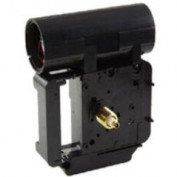 61
61Clock Parts (Clock Replacement Parts)
Joined 3 years ago from Culver City, CA 90230
New Electronic Clock Movements
Clock movements are the engines, or motors, that manage the turning as well as positioning of the hands for proper time informing. Clock movements were generally mechanical and analog, but in modern-day times they are nearly exclusively digital, as well as either analog or electronic. In any case, the function needed boils down to the dimension of the angle subtended by each hand at every minute.
Clock movements are usually described as electric motors, and also the terms are essentially compatible. The force behind a mechanical one was either a coiled spring or a hanging weight causing a flywheel to turn. To stop "freewheeling," or runaway turning, pendulums and also escapement mechanisms were utilized, establishing an oscillation that had actually a specifically obtained frequency.
The modern electronic movement acquires its power from a quartz crystal shaking at a certain regularity that corresponds to the geometry of the crystal. With a voltage drop applied to the crystal, it discharges a collection of pulses at the powerful regularity. Building up the number of pulses into an electronic register keeps an eye on the amount of expired time.
This running overall of pulses is a high multiple of the seconds and minutes required for telling time, so software program partitions the number down to something beneficial. The mechanical analog of this process is completed making use of a network of gears in certain proportions. In both the digital and mechanical method, the development of every second causes the pre-owned to subtend another 6 levels of arc.
One more register builds up secs right into mins, and also a third counts minutes into hours. When the matching limit is crossed, the family member hand is progressed an additional tick. Eventually, each register gets reset back to absolutely no, developing a general cycle when every little thing begins again once again.
This "at some point" generally indicates 12 hrs, yet there's no reason it can't be prolonged well beyond that. It's practically say goodbye to difficult than setting a specification in the movement software. So, it's simple to double the cycle to 24 hours (which would need a different dial), but easily offered are electric motors that go out a week or even a month.
These latter two extensions call for an added hand to point to the day of the week or the day in the month, specifically. Yet a different kind of expansion uses a cycle of 1 day as well as 50 minutes, which represents the duration of the lunar transformation around the earth. Thus, it can be utilized to present the current degree of the trend (if calibrated to your region of the sea).
There are also movements for showing weather condition phenomena, such as temperature or humidity. Unlike the trend degree, which is a regular reoccurrence like time, such sensations vary within a particular range, and the worths have to be digitized from sensor input. The corresponding dial is calibrated to make sure that the hand rotates through less than one full circle.
Keep in mind that electronic clock movements are capable of a lot greater than their mechanical counterparts as a result of the software facet. The physical positioning of the hand or hands is the same for both, but the derivation of position is an order of size more made complex for the mechanical version.
Movements show function sets, and some functions we haven't also explained. Keep in mind that typical motors are created for clocks less than 12-14 inches in size, as their torque restriction can't turn longer minute hands. It is feasible to construct bigger clocks (even up to 6 feet across!), however you have to order the high-torque variation of the movement the attribute collection of which you wish to carry out.
The majority of motors work on batteries (generally AA or C), though various other power alternatives are often offered. You can also locate novelties such as pendulums or chimes. There is no end to the satisfaction one can originate from modern-day digital clock movements.